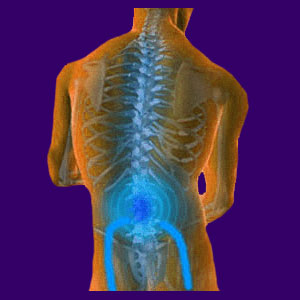
Spinal stenosis pain is a rare occurrence from this very common structural condition. This is because the overwhelming majority of people diagnosed with stenosis demonstrate minor cases which have been clinically proven not to cause symptoms. Remember, a narrowed central canal is not, in itself, inherently painful at all. It is only when a nerve structure is compressed that symptoms will develop and this does not represent the typical case of mild or even moderate stenotic change.
Spinal stenosis is a condition in which the spinal canal is narrowed either by back injury, or more commonly, degenerative processes. Stenosis is a normal part of the aging process for most people. It is also one of the scapegoat conditions that are often blamed for enacting chronic back pain, even without definitive evidence of any neurological involvement.
This essay provides explanations of how stenosis can cause pain, as well as how some painful symptoms are mistakenly linked to canal narrowing conditions.
Causes of Spinal Stenosis Pain
Spinal stenosis describes a narrowing of the spinal canal. This is the area of the spine that contains the spinal cord and the lumbar spinal nerve roots. This passageway is usually more than wide enough to provide the cord with plenty of room to function normally.
As we age, processes such as arthritis in the spine and degenerative disc disease contribute to the narrowing of this spinal canal. The condition can be diagnosed by spinal MRI or CT scan.\Many patients discover that they have stenosis when undergoing imaging for an unrelated condition. They have not experienced any pain or symptoms from this condition… until now.
The nocebo effect of this scary diagnosis can cause the start of symptoms in patients who demonstrated no back or neck pain previously. It can also make the pain of pre-existing conditions much, much worse. The description of the spinal canal closing in and clamping down on your spinal cord is enough to scare anyone half to death.
Some patients do have pain and this is why they seek diagnostic evaluation. When stenosis is advanced and focused, it can certainly be the source of pain and large areas of paresthesia. However, when the stenotic change is conservative, there is likely to be some other causative mechanism enacting the pain, with the stenosis being coincidental.
Spinal Stenosis Overview
Central canal stenosis is a normal condition to experience as we age. Arthritis and disc degeneration are also normal parts of our journey to old age. The majority of people with spinal stenosis do not have any pain. Of the few patients who do have pain, the stenosis is sometimes a coincidental condition. This means that the pain exists, but it is not coming from the stenotic alterations.
Patients with significant spinal structural issues, such as severe scoliosis, hyperlordosis, hyperkyphosis, large central herniations and advanced arthritic changes may be suffering from stenosis which not only causes pain, but also imparts major neurological dysfunction.
Some of these patients will not be able to stand or walk and some may also suffer incontinence, sexual dysfunction and other very disabling consequences.
Spinal Stenosis Pain Solutions
Mild to moderate stenosis is usually nothing to fear. If you have minor stenosis, relax. It is not likely that it will cause you any significant problems in your life. Just make sure to keep perspective on the facts of the condition and stay in contact with your doctor for regular monitoring of the patency of the interior central canal diameter.
If you are victimized by the nocebo effect of the condition, I can almost guarantee you will suffer greatly with pain. It is really a matter of subconscious suggestion being that powerful as to actually source symptoms.
For patients with advanced stenosis-related spinal pain, take time to research your treatment options carefully. Do not rush into surgery and be sure to get more than one opinion on the best course of action for your individual case profile.





